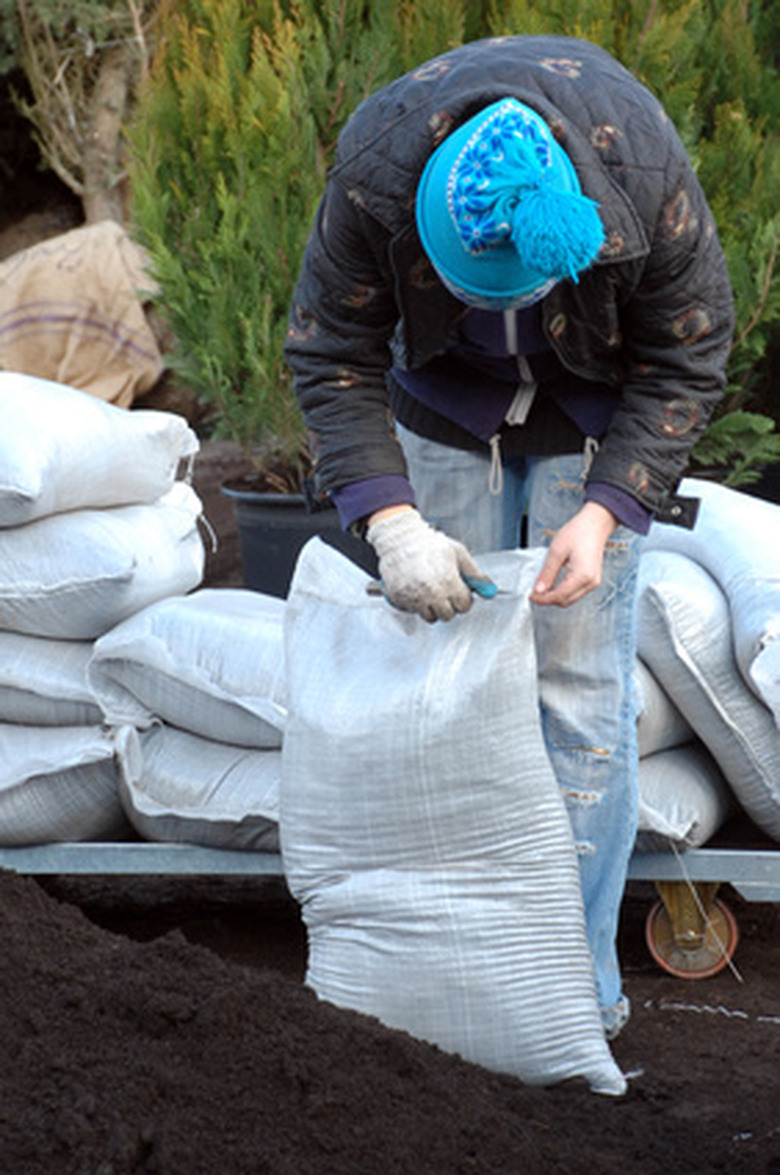How To Spread Peat Moss On Large Areas
Gardeners with large planting areas where they wish to spread peat moss will require the help of a special broadcast spreader called a peat spreader, or a cage roller. When the peat spreader is loaded with fine peat moss, it quickly spreads peat moss at just the depth necessary to cover a planting or growing area. A peat spreader is especially helpful when you wish to spread peat moss over a newly seeded lawn.
Step 1
Spread the tarp near the area where you will be applying the peat moss.
Step 2
Dump the peat moss out onto the tarp and work through the peat moss to break up the clumps. The peat moss must be finely broken up so it sifts through the peat spreader uniformly.
Step 3
Position the peat spreader over the tarp to contain spills. Open the peat spreader door and fill it to capacity with the peat moss. Close the door of the peat spreader tightly.
- Gardeners with large planting areas where they wish to spread peat moss will require the help of a special broadcast spreader called a peat spreader, or a cage roller.
- Open the peat spreader door and fill it to capacity with the peat moss.
Step 4
Place the peat spreader at the edge of the application area and begin pushing it over the area to apply the peat moss. Watch behind the peat spreader to see how thick your layer of peat moss is on the application area; quicken your pace for a thinner layer, and slow your pace for a thicker layer. You may have to re-cover areas if you desire a thicker layer of peat moss over your planting area.
Step 5
Continue pushing the peat spreader until you cover the entire area with an even layer.
Peat & Peat Moss
Peat is a brown material with a soil-like composition that is generally found growing in acidic and boggy soils. Peat consists of decaying vegetable matter and — when added to soil — enriches the area for better plant life. Peat can consist of either sapric, hemic or fibric materials, each with its own level of decomposition. However, peat moss consists of an absorbent moss that increases the acidity level of soils when added to it. Peat moss helps retain water in the soil, adds body to sand soils and loosens soil containing a high amount of heavy clay. Since peat moss has a low pH level, garden lime may be needed if using it as mulch. Both peat and peat moss can be used as a soil amendment or as an organic mulch. However, peat and peat moss are not suitable substitutes for fertilizers and you should always use the appropriate type of and proper amount of fertilizer for your particular plant.
- Peat is a brown material with a soil-like composition that is generally found growing in acidic and boggy soils.
- Since peat moss has a low pH level, garden lime may be needed if using it as mulch.
Peat & Peat Moss
Peat is a brown material with a soil-like composition that is generally found growing in acidic and boggy soils. Peat consists of decaying vegetable matter and — when added to soil — enriches the area for better plant life. Peat can consist of either sapric, hemic or fibric materials, each with its own level of decomposition. However, peat moss consists of an absorbent moss that increases the acidity level of soils when added to it. Peat moss helps retain water in the soil, adds body to sand soils and loosens soil containing a high amount of heavy clay. Since peat moss has a low pH level, garden lime may be needed if using it as mulch. Both peat and peat moss can be used as a soil amendment or as an organic mulch. However, peat and peat moss are not suitable substitutes for fertilizers and you should always use the appropriate type of and proper amount of fertilizer for your particular plant.
- Peat is a brown material with a soil-like composition that is generally found growing in acidic and boggy soils.
- Since peat moss has a low pH level, garden lime may be needed if using it as mulch.
Things Needed
- Tarp
- Peat moss
- Peat spreader
Tip
Wear gardening gloves to keep your hands clean as you break up the peat moss.
References
- Consumer Reports: Repairing an Existing Lawn
- University of California: The UC Guide to Healthy Lawns
- Harvest to Table: Organic Fertilizers and Soil Amendments
- Sunset: Good Earth
- University of California Cooperative Extension Master Gardener: Mulching – A Must
- Harvest to Table: Organic Fertilizers and Soil Amendments
- Sunset: Good Earth
- University of California Cooperative Extension Master Gardener: Mulching – A Must
